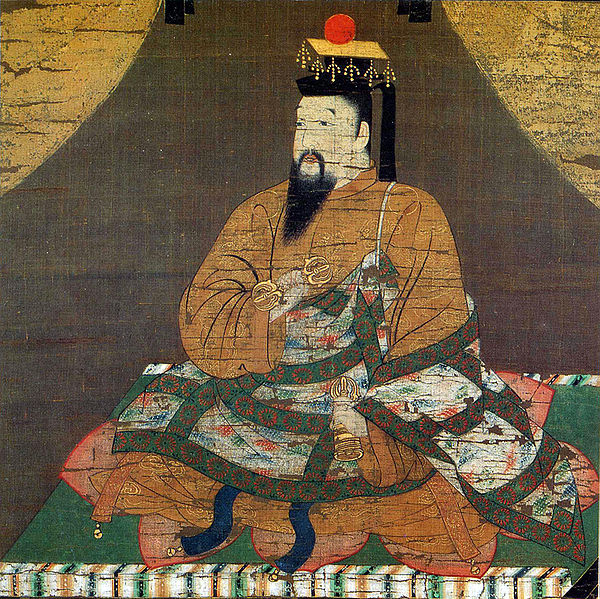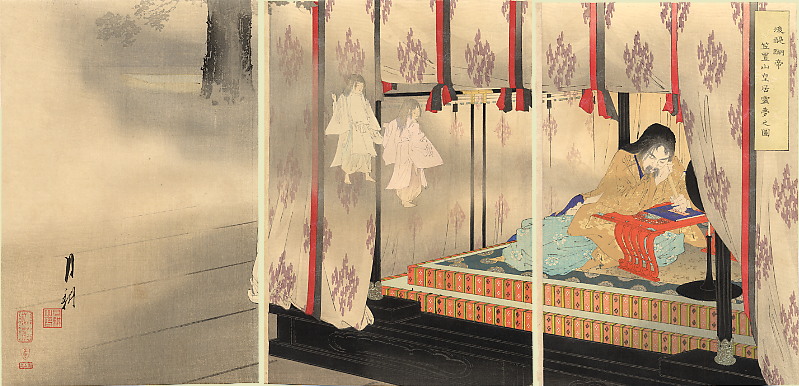<Back to Index>
- Geophysicist Jean Jacques d'Ortous de Mairan, 1678
- Painter and Designer Bart van der Leck, 1876
- Emperor of Japan Go-Daigo, 1288
PAGE SPONSOR

Emperor Go-Daigo (後醍醐天皇 Go-Daigo-tennō) (November 26, 1288 – September 19, 1339) was the 96th emperor of Japan, according to the traditional order of succession.
Post - Meiji historians construe Go-Daigo's reign to span 1318 - 1339; however, pre - Meiji accounts of his reign considered the years of his reign to encompass only between 1318 - 1332. Pre - Meiji scholars also considered Go-Daigō a pretender Emperor in the years from 1336 through 1339.
This 14th century sovereign was named after the 9th century Emperor Daigo and go- (後),
translates literally as "later;" and thus, he is sometimes called the
'Later Emperor Daigo'. The Japanese word 'go' has also been translated
to mean the "second one;" and in some older sources, this emperor may be
identified as 'Daigo, the second,' or as 'Daigo II.'
Before his ascension to the Chrysanthemum Throne, his personal name (his imina) was Takaharu - shinnō (尊治親王).
He was the second son of the Daikakuji-tō emperor, Emperor Go-Uda. His mother was Fujiwara no Chūshi / Tadako (藤原忠子), daughter of Fujiwara no Tadatsugu (Itsutsuji Tadatsugu) (藤原忠継/五辻忠継). She became Nyoin called Dantenmon-in (談天門院).
Emperor Go-Daigo's ideal was the Engi era (901 - 923) during the reign of Emperor Daigo, a period of direct imperial rule. An emperor's posthumous name was
normally chosen after his death, but Emperor Go-Daigo chose his
personally during his lifetime, to share it with Emperor Daigo.
Emperor Go-Daigo became emperor at the age of 31, in the prime of his life.
- 1308 (Enkyō 1): At the death of Emperor Go-Nijō, Hanazono accedes to the Chrysanthemum Throne at age 12 years; and Takaharu - shinnō, the second son of former Emperor Go-Uda is elevated as Crown Prince and heir apparent under the direction of the Kamakura shogunate.
- March 29, 1318 (Bunpō 2, 26th day of 2nd month): In the 11th year of Hanazono - tennō 's reign (花園天皇11年), the emperor abdicated; and the succession (senso) was received by his cousin, the second son of former Emperor Go-Uda. Shortly thereafter, Emperor Go-Daigo is said to have acceded to the throne (sokui).
- 1319 (Bunpō 3, 4th month): Emperor Go-Daigo caused the nengō to be changed to Gen'ō to mark the beginning of his reign.
In 1324, with the discovery of Emperor Go-Daigo's plans to overthrow the Kamakura Shogunate, the Rokuhara Tandai disposed of his close associate Hino Suketomo in the Shōchū Incident.
In the Genkō Incident of 1331, Emperor Go-Daigo's plans were again discovered, this time by a betrayal by his close associate Yoshida Sadafusa. He quickly hid the Sacred Treasures in a secluded castle in Kasagiyama (the modern town of Kasagi, Sōraku district, Kyōto Prefecture) and raised an army, but the castle fell to the Bakufu's army the following year, and they enthroned Emperor Kōgon, exiling Emperor Go-Daigo to Oki Province (the Oki Islands in modern day Shimane Prefecture), the same place to which Emperor Go-Toba had been exiled after the Jōkyū War of 1221.
In 1333, Emperor Go-Daigo escaped from Oki with the help of Nawa Nagatoshi and his family, raising an army at Funagami Mountain in Hōki Province (the modern town of Kotoura in Tōhaku District, Tottori Prefecture). Ashikaga Takauji, who had been sent by the Bakufu to find and destroy this army, sided with the Emperor and captured the Rokuhara Tandai. Immediately following this, Nitta Yoshisada, who had raised an army in the East, destroyed the Hōjō clan and captured the Bakufu.
Returning to Kyōto, Emperor Go-Daigo took the throne from Emperor Kōgon and began the Kenmu Restoration. The Restoration was ostensibly a revival of the older ways, but, in fact, the emperor had his eye set on an imperial dictatorship like that of the emperor of China. He wanted to imitate the Chinese in all their ways and become the most powerful ruler in the East. Impatient reforms, litigation over land rights, rewards, and the exclusion of the samurai from the political order caused much complaining, and his political order began to fall apart. In 1335, Ashikaga Takauji, who had travelled to eastern Japan without obtaining an imperial edict in order to suppress the Nakasendai Rebellion, became disaffected with the Restoration. Emperor Go-Daigo ordered Nitta Yoshisada to track down and destroy Ashikaga. Ashikaga defeated Nitta Yoshisada at the Battle of Takenoshita, Hakone. Kusunoki Masashige and Kitabatake Akiie, in communication with Kyoto, smashed the Ashikaga army. Takauji fled to Kyūshū, but the following year, after restructuring his army in Kyūshū, he again approached Kyōto. Kusunoki Masashige proposed a reconciliation with Ashikaga Takauji to the emperor, but Go-Daigo rejected this. He ordered Masashige and Yoshisada to destroy Takauji. Kusunoki's army was defeated at the Battle of Minatogawa (湊川の戦い).
When Ashikaga's army entered Kyōto, Emperor Go-Daigo resisted, fleeing to Mount Hiei, but seeking reconciliation, he sent the Sacred Treasures to the Ashikaga side. Takauji enthroned the Jimyōin-tō emperor, Kōmyō, and officially began his shogunate with the enactment of the Kenmu Law Code.
Go-Daigo escaped from the capital, the Sacred Treasures that he had handed over to the Ashikaga being counterfeit, and set up the Southern Court among the mountains of Yoshino, beginning the Period of Northern and Southern Courts in which the Northern Dynasty in Kyōto and the Southern Dynasty in Yoshino faced off against each other.
Emperor Go-Daigo ordered Imperial Prince Kaneyoshi to Kyūshū and Nitta Yoshisada and Imperial Prince Tsuneyoshi to Hokuriku, and so forth, dispatching his sons all over, so that they could oppose the Northern Court.
- September 18, 1339 (Ryakuō 2, 15th day of the 8th month): In the 21st year of Go-Daigo's reign, the emperor abdicated at Yoshino in favor of his son, Noriyoshi - shinnō, who would become Emperor Go-Murakami.
- September 19, 1339 (Ryakuō 2, 16th day of the 8th month): Go-Daigo died.
The actual site of Go-Daigo's grave is settled. This emperor is traditionally venerated at a memorial Shinto shrine (misasagi) at Nara.
The Imperial Household Agency designates this location as Go-Daigo's mausoleum. It is formally named Tō-no-o no misasagi.
Kugyō (公卿) is a collective term for the very few most powerful men attached to the court of the Emperor of Japan in pre - Meiji eras. Even during those years in which the court's actual influence outside the palace walls was minimal, the hierarchic organization persisted. In general, this elite group included only three to four men at a time. These were hereditary courtiers whose experience and background would have brought them to the pinnacle of a life's career. During Go-Daigo's reign, this apex of the Daijō-kan included: Kampaku, Nijō Michihira, 1316 – 1318; Kampaku, Ichijō Uchitsune, 1318 – 1323; Kampaku, Kujō Fusazane, 1323 – 1324; Kampaku, Takatsukasa Fuyuhira, 1324 – 1327; Kampaku, Nijō Michihira, 1327 – 1330; Kampaku, Konoe Tsunetada, 1330; Kampaku, Takatsukasa Fuyunori, 1330 – 1333; Sadaijin; Udaijin; Naidaijin; Dainagon.
